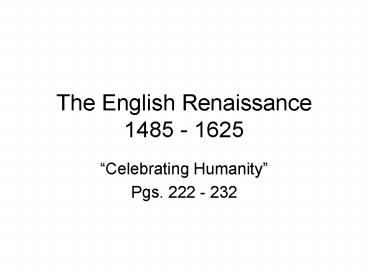The English Renaissance 1485 - 1625 - PowerPoint PPT Presentation
1 / 11
Title:
The English Renaissance 1485 - 1625
Description:
The English Renaissance 1485 - 1625 Celebrating Humanity Pgs. 222 - 232 Tell the story of The Renaissance Shepard, Gerathy, Donovan Tell the story of the ... – PowerPoint PPT presentation
Number of Views:279
Avg rating:3.0/5.0
Title: The English Renaissance 1485 - 1625
1
The English Renaissance1485 - 1625
- Celebrating Humanity
- Pgs. 222 - 232
2
Tell the story of The Renaissance
- Shepard, Gerathy, Donovan
3
Tell the story of the Protestant Reformation
- Barbella, Peck, Durkin
4
Tell the story of the Henrys
- Mott, Mortenson, Fernandez
5
The Queens (Bloody,Liz,Scots)
- Mary I
- restored roman catholic practices to the church
of England - Restored authority of the pope in England
- She earned the nickname Bloody Mary by
executing 300 Protestants - Elizabeth I Mary Stuart
- Half sister of Mary I
- Put an end to the religious turmoil between
Catholics and protestants - Well educated
- Her cousin, Mary Stuart, was the queen of
Scotland by birth and next in line for the thrown - Elizabeth's mothers marriage to Henry VIII was
not recognized by the Catholics - Catholics believed Mary Stuart was the rightful
queen - Elizabeth had Mary imprisoned for 18 years
because of her threat to the thrown - While in prison Mary organized numerous Catholic
plots against Elizabeth - After parliament order Elizabeth had Mary
executed - Making Mary a catholic Martyr
6
The Jacobean Era
- The Jacobean Era and Prose
- The scholars still preferred to write in Latin,
therefore the English prose still had Latin
influence. - The prose of Sidney, Nashe, and Raleigh, were
several Elizabethan poets that contributed major
works of Jacobean prose. - Sir Philip Sidney's defense of poesie is one of
the earliest works of English literary criticism.
- Sir Francis Bacon was
- Leading prose writer of the English renaissance
- His greatest work Novum Organum made major
contributions to natural science and philosophy - The King James Bible
- Most monumental prose achievement of the
renaissance. This was the english translation of
the bible. - Fifty four scholars labored for seven years
- It widely quoted influential works in the English
Language.
7
Renaissance Lit. (3 types)
- Elizabethan Poetry
- - Poets perfected the sonnet and experimented
- - Sydney, Spencer, and Shakespeare were the top
poets - - Popular style was the sonnet cycle, which was
a series of sonnets that formed a story - - Christopher Marlowe helped popularize pastoral
verse - - Idealizes the rustic simplicity of rural life
- Elizabethan Drama
- - turned away from religious subjects and began
to write complex and sophisticated stories - - reintroduced dramas and tragedies
- - popular writer were Christopher Marlowe and
William Shakespeare - Elizabethan and Jacobean Prose
- - liked writing in Latin
- - used long words and ornate sentences
- - kings James bible- monumental prose
8
Protestant Reformation
- As nationalism grew many Europeans began to
question the Roman Catholic Church - Some felt the church officials were corrupt and
questioned their teachings - A scholar, Desiderius Erasmus, raised many
questions about interpretations involving
morality and religion - Martin Luther, a German monk, staged a protest
that divided the Roman Catholic Church and the
new Christian denomination known as Lutheranism - This Process was called the Protestant
Reformation
9
The Renaissance
- Started in Italian city-states in 1350 and spread
towards England in 1485 - Supported rebirth of civilization through
learning and arts - Led to advances in English sea exploration
- -Advances in technology (compass/astronomy)
- Columbus arrived in Western Hemisphere in 1492
- Age of Exploration began in 1497- John Cabot
reached Newfoundland
10
Story of the Henrys
- Henry VII
- -rebuilt nations treasury
- -Reestablished law and order
- -Restored prestige in the monarchy
- Henry VIII
- -son of King VII
- -Tried for annulment, remarried anyway
- -Broke relationship between church and state
- -Seized churchs property
King Edward VI -son of Henry VII -Became king at
9, and died at 15 -Replaced Latin to English in
church -Changed England to a Protestant
nation Queen Elizabeth -Edwards half
sister -Reestablish monarch supremacy -Instituted
religious compromise between Catholic and
Protestant
11
Changing English Language (232)
- Keena, Dessel, Viktoriya
- Shakespeare used 20,000 words in his works, and
over 1,700 of them were created by himself - Reading his work is like witnessing the birth of
a language(pg 232)































